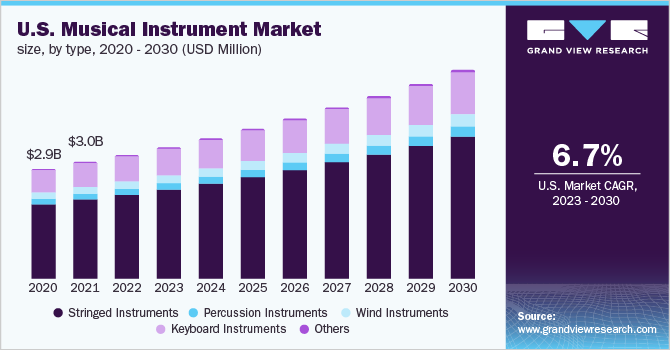The global musical instrument market worldwide was valued at an estimated $14.20 billion in 2022. It is anticipated to expand to $25.13 billion by 2030, showing a compound annual growth rate (CAGR) of 7.4% from 2023 to 2030. This growth is expected to be fueled by greater access to musical education, made possible by numerous government-backed initiatives across different countries aimed at promoting music globally.
The COVID-19 pandemic significantly hindered the industry's progress. Widespread lockdowns led to the closure of non-essential businesses, which in turn disrupted the supply and distribution networks for musical instruments, negatively affecting manufacturers. Furthermore, the cancellation of live musical events, festivals, and concerts resulted in a major loss of the primary market for these products.

Conversely, the increasing popularity of live concerts and performances is now driving the industry forward. These events serve as a means for people to enhance their emotional well-being, improve their mood, and foster social connections by bringing together individuals with shared musical tastes and experiences. This has resulted in a surge of interest in attending live performances. For example, according to Bandsintown, a popular live music app, the total number of tickets sold in the U.S. in January 2022 was double the amount sold in 2019. This trend is poised to have a substantial positive impact on market growth in the coming years.
Key Market Insights:
- Largest Regional Share: Asia Pacific accounted for the highest revenue share, exceeding 41% in 2022. This region is also projected to be the fastest-growing, with a CAGR of more than 7%. The music industry in Asia Pacific is set for considerable change, driven by the increasing influence of Western music in developing nations like India and China, which is raising awareness and demand for high-quality instruments.
- By Type: The keyboard instrument segment is projected to be the fastest-growing, with a CAGR of 7.4% during the forecast period from 2023 to 2030. This category includes instruments such as the piano, accordion, and keyboard.
- Fastest Sub-segment: Within the keyboard instrument segment, pianos are expected to experience the highest growth rate, with a CAGR of 7.8% over the forecast period.
- Distribution Channel: The market is witnessing a shift toward online sales. The convenience of access and rising consumer preference for purchasing instruments online are key factors boosting this channel.
Order a free sample PDF of the Musical Instrument Market Intelligence Study, published by Grand View Research.
Market Size & Forecast
- 2022 Market Size: USD 14.20 Billion
- 2030 Projected Market Size: USD 25.13 Billion
- CAGR (2023-2030): 7.4%
- Asia Pacific: Largest market in 2022
Key Companies & Market Share Insights
The musical instruments market is highly competitive and fragmented, with numerous players striving for market share. Leading companies are heavily investing in research and development to introduce innovative, user-friendly instruments with enhanced sound quality. Additionally, strategic initiatives such as mergers and acquisitions, joint ventures, educational workshops, and market expansions are being adopted to boost sales and brand reach.
For example, in March 2022, Yamaha, a prominent name in the industry, launched the PSR-E473 portable keyboard. This 61-key touch-sensitive instrument delivers professional-grade sound, catering to both beginners and seasoned musicians.
Key Players
- Casio Computer Co., Ltd.
- F. Martin & Co., Inc.
- D'addario & Company, Inc.
- Eastman Music Company
- Fender Musical Instruments Corporation
- Kawai Musical Instruments Mfg. Co., Ltd.
- Roland Corporation
- Steinway & Sons
- Yamaha Corporation
- Yanagisawa Wind Instruments Co., Ltd.
Explore Horizon Databook – The world's most expansive market intelligence platform developed by Grand View Research.
Conclusion
The global musical instrument market is experiencing significant growth, driven by increased access to music education and the rising popularity of live concerts. The shift towards online sales and advancements in instrument technology are also contributing to this expansion. While the industry faced challenges during the COVID-19 pandemic, it has shown resilience and is propelled by a major market in the Asia Pacific region. The keyboard and stringed instrument segments are particularly notable for their growth.





